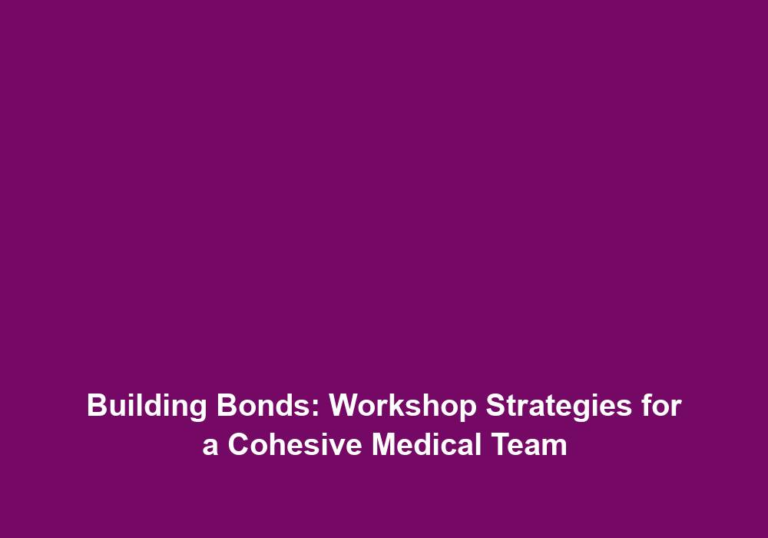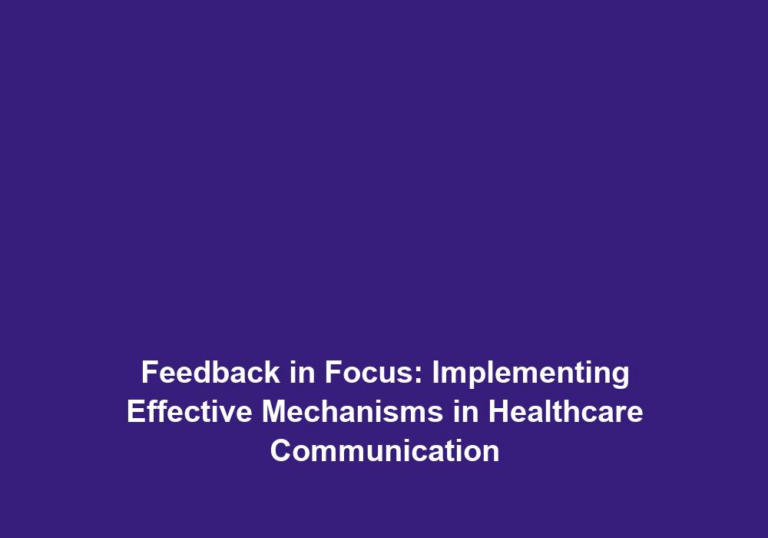Clinic Checkpoints: Navigating Performance Evaluations for Medical Staff
Performance evaluations play a crucial role in ensuring the success and effectiveness of any organization, including medical clinics. In the healthcare industry, where the quality of care provided to patients is of utmost importance, it becomes even more essential to conduct regular performance evaluations for medical staff. These evaluations not only help in assessing the performance of individual healthcare professionals but also serve as a valuable tool for identifying areas of improvement and ensuring the overall growth of the clinic.
The Importance of Performance Evaluations
Performance evaluations provide a structured framework for reviewing and assessing the performance and competency of medical staff. They offer an opportunity for supervisors and administrators to objectively evaluate the skills, knowledge, and professionalism of healthcare professionals, including doctors, nurses, and support staff. By conducting regular evaluations, clinics can:
- Identify Strengths and Weaknesses: Performance evaluations enable clinics to identify the strengths and weaknesses of their medical staff. This information can be instrumental in making informed decisions regarding staff assignments, promotions, and training opportunities.
In identifying the strengths and weaknesses of medical staff, clinics can ensure that they are leveraging the unique skills and abilities of each individual. By recognizing and capitalizing on strengths, clinics can assign tasks and responsibilities that align with the expertise of medical staff, leading to increased job satisfaction and improved performance. On the other hand, identifying weaknesses allows clinics to provide targeted training and development opportunities to address any knowledge or skill gaps. This can result in improved performance and overall effectiveness in delivering patient care.
- Maintain Quality of Care: Regular evaluations help clinics ensure that their medical staff is providing high-quality care to patients. By assessing the performance of healthcare professionals, clinics can identify any gaps in knowledge, skills, or patient care practices that may require attention or improvement.
Performance evaluations provide an opportunity to assess the clinical competency and patient care skills of medical staff. By evaluating these aspects, clinics can identify any areas where healthcare professionals may need additional support or training. This ensures that medical staff are equipped with the necessary knowledge and skills to provide the highest quality of care to patients. Furthermore, performance evaluations can uncover any communication issues or challenges in teamwork and collaboration, which are crucial for maintaining a positive patient experience and delivering coordinated care.
- Encourage Professional Growth: Performance evaluations provide an opportunity for medical staff to receive feedback on their performance and to set goals for their professional development. By offering constructive feedback and guidance, clinics can support the growth and advancement of their healthcare professionals.
Through performance evaluations, clinics can provide valuable feedback to medical staff, highlighting their strengths and areas for improvement. This feedback serves as a foundation for setting goals that align with the professional growth and development of healthcare professionals. By setting SMART goals, medical staff have a clear roadmap for improvement, allowing them to enhance their skills, expand their knowledge, and advance their careers. This focus on professional growth not only benefits individual healthcare professionals but also contributes to the overall success of the clinic.
- Address Performance Issues: Performance evaluations also play a critical role in addressing any performance issues or concerns. If a healthcare professional is consistently falling short of expectations, evaluations can help identify the root causes of the problem and initiate appropriate interventions, such as additional training or mentoring.
Performance evaluations provide an opportunity to proactively address performance issues before they escalate. By identifying the underlying causes of poor performance, clinics can implement targeted interventions to support medical staff in overcoming challenges and improving their performance. This may involve providing additional resources, offering mentoring opportunities, or facilitating professional development programs. Addressing performance issues in a timely and constructive manner not only benefits the individual healthcare professional but also contributes to the overall success and reputation of the clinic.
Conducting Effective Performance Evaluations
To ensure that performance evaluations are effective and yield meaningful results, clinics should follow a structured approach. Here are some essential steps in conducting performance evaluations for medical staff:
1. Establish Clear Evaluation Criteria
Before conducting performance evaluations, it is crucial to establish clear and objective evaluation criteria. This ensures that the evaluation process is fair, consistent, and aligned with the clinic’s goals and expectations. Evaluation criteria may include:
- Clinical competency: Assessing the medical knowledge and technical skills of healthcare professionals.
- Patient care skills: Evaluating the ability to provide compassionate and effective care to patients.
- Communication skills: Assessing the effectiveness of communication with patients, colleagues, and other stakeholders.
- Teamwork and collaboration: Evaluating the ability to work collaboratively with other members of the healthcare team.
- Professionalism and ethics: Assessing adherence to ethical standards and professionalism in interactions with patients and colleagues.
- Compliance with policies and procedures: Evaluating the adherence to clinic policies, procedures, and regulatory requirements.
- Continuous learning and development: Assessing the commitment to ongoing learning, professional development, and staying up-to-date with advancements in the healthcare field.
By establishing clear evaluation criteria, clinics ensure that the evaluation process is focused on the essential aspects of medical staff performance. This clarity enables evaluators to provide objective and constructive feedback, as well as identify areas that require improvement or further development.
2. Set SMART Goals
Setting Specific, Measurable, Achievable, Relevant, and Time-bound (SMART) goals is essential for guiding the evaluation process. Encourage medical staff to set goals that are aligned with their professional growth and the clinic’s objectives. SMART goals provide a clear roadmap for improvement and give evaluators a benchmark against which to measure progress.
By setting SMART goals, medical staff can clearly define what they want to achieve and how they plan to achieve it. This specificity allows both the evaluators and the healthcare professionals to track progress and measure success. SMART goals also provide motivation and a sense of purpose, as they are tailored to the individual’s aspirations and the clinic’s overall mission.
3. Gather Feedback from Multiple Sources
To ensure a comprehensive evaluation, gather feedback from multiple sources, including supervisors, peers, patients, and self-assessment. Each source provides a unique perspective on the medical staff’s performance and helps identify areas of strength and areas that require improvement. Collecting feedback from various sources also reduces the impact of bias and enhances the credibility and reliability of the evaluation process.
By gathering feedback from multiple sources, clinics gain a well-rounded understanding of the medical staff’s performance. Feedback from supervisors provides insights into the professional conduct and adherence to clinic policies, while feedback from peers offers perspectives on teamwork and collaboration. Patient feedback provides valuable insights into the quality of care and the patient experience. Additionally, self-assessment allows healthcare professionals to reflect on their own performance and identify areas for growth. The combination of these diverse perspectives ensures a comprehensive evaluation that captures the full spectrum of medical staff performance.
4. Conduct Regular Evaluation Meetings
Schedule regular evaluation meetings with medical staff to discuss their performance, progress, and any areas that require attention. These meetings should be conducted in a supportive and constructive manner, focusing on both positive aspects and areas for improvement. Allow medical staff to share their perspectives and concerns during these meetings, fostering open communication and promoting a collaborative approach to professional development.
Regular evaluation meetings provide an opportunity for ongoing dialogue between evaluators and medical staff. These meetings allow for the exchange of feedback, clarification of expectations, and identification of strategies for improvement. By creating a supportive and constructive environment, clinics can encourage medical staff to actively engage in their own development and take ownership of their performance. These meetings also provide a platform for medical staff to voice their concerns, seek guidance, and contribute to the overall improvement of the clinic.
5. Document and Track Performance
It is crucial to maintain accurate and detailed records of performance evaluations. Document the feedback provided, goals set, and any action plans formulated. This documentation serves as a valuable resource for tracking progress over time and provides a reference point for future evaluations. Regularly reviewing and updating these records ensures that performance evaluations are an ongoing process rather than a one-time event.
By documenting performance evaluations, clinics create a historical record that allows for the tracking of progress and the identification of trends over time. This documentation also serves as a reference for future evaluations, ensuring consistency and providing a basis for comparison. By regularly reviewing and updating performance records, clinics can adapt their evaluation process to changing circumstances and continuously improve the effectiveness of performance evaluations.
Conclusion
Performance evaluations for medical staff are indispensable for the success and growth of clinics. By establishing clear evaluation criteria, setting SMART goals, gathering feedback from multiple sources, conducting regular evaluation meetings, and documenting performance, clinics can navigate the performance evaluation process effectively. These evaluations not only help identify areas of improvement but also facilitate the professional growth and development of medical staff, ultimately contributing to the delivery of high-quality patient care.







